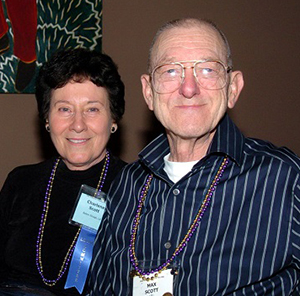In Memoriam: Louie "Max" Scott
1934-2023
by Charles A. Wilson IV, CHP*



"Just use the Max Scott method," a regulator suggested nearly a year after Louie Max Scott passed away, reminding me of the great influence Dr. Scott had on the health physics community and the privilege I had to know him. Well over a decade prior, I met Dr. Scott as a guest lecturer for an introductory health physics course I was taking where he was teaching how to interpret a decay scheme chart. I, and I assume my classmates as well, nodded blankly when Dr. Scott asked, "Does that make sense to everyone?" The potential of class ending early was palpable. "Great, once you explain it back to me you may leave," Dr. Scott told the class... I was an hour late getting out of class that day, but left the lecture equipped with a new skill and remain forever grateful for Dr. Scott's time and passion for the health physics field.
Louie "Max" Scott was born on 9 May 1934 to L.B. and Maude Scott in Nolan County (Sweetwater) Texas where he grew up as part of a farming family. He graduated from Newman High School, and after graduating with a BS degree from Texas A&M in 1955, he served in the US Army. Max later earned both an MS and a PhD from Purdue University, studying population genetics with minors in statistics and physiology.
Max was a health physics specialist at the Atomic Energy Commission Y-12 nuclear weapons plant in Oak Ridge, Tennessee, from 1961 to 1977. While there, he coauthored crucial papers on detection and evaluation of inhaled uranium and pioneered the use of in vivo gamma spectroscopy for the detection of uranium deposited in the lungs. He then moved to be the corporate director of radiation heath physics for Gulf Oil Corporation, where he devised a mining plan that allowed for the recovery of highly concentrated uranium ore deposits with minimal radiation exposure.
After his time with Gulf Oil Corporation, Max joined Louisiana State University (LSU) in 1985, where he served many roles, including associate professor of nuclear science, adjunct associate professor of physics and astronomy, campus radiation safety officer, and system radiation safety officer. He remained LSU system radiation safety officer until 2020. Max was a hard worker and inspirational to everyone who interacted with him. Many times at LSU when Max overheard me complain about deadlines, he would kindly smirk and say, "Well what are you doing between midnight and 6 am?"
While at LSU, Max developed a technique for the rapid field analysis of 226Ra in soil ("the Max Scott method"), which is used extensively throughout Louisiana. Max was the author or coauthor of over 30 peer review journal publications and served on several graduate student committees. Max was once elated when a student worker at the radiation safety office stopped him after entering the building, ordering him to identify himself. "She should be commended," he delighted after seeing a student stand for radiation protection.
Max was the 2006 recipient of the Health Physics Society (HPS) Founders Award in recognition of exceptional service to the HPS and the health physics profession. He was also a Life Fellow of the Society. Max was certified by the American Board of Health Physics, was a Full Member of Sigma Xi, and served on or chaired the HPS Nominating Committee, Standards Committee, Annual Meeting Place Committee, Program Committee, Uranium Bioassay Subcommittee, and Naturally Occurring Radioactive Material (NORM) Subcommittee and the Nominating Committee of the American Academy of Health Physics. For the HPS, he was also president of the Deep South Chapter and the East Tennessee Chapter and served on the Board of Directors of the Western Pennsylvania Chapter, the Deep South Chapter, and the East Tennessee Chapter. He was a designated technical expert for the International Atomic Energy Agency. He also consulted with over 100 groups, including the British Petroleum Company, General Electric's Nuclear Fuel Division, Goodyear Atomic, Kerr McGee, Oak Ridge Associate Universities' Center for Epidemiologic Research, Rio Algom Corporation, and Westinghouse's Nuclear Fuel Division.
Max made many great contributions outside of health physics. He was a Louisiana representative on the Internal Revenue Service Taxpayers Advocacy Panel, and he volunteered for the AARP Tax Aide Program, Baton Rouge Hospice, Baton Rouge Foodbank, Baton Rouge Library, St. Agnes soup kitchen and Senior Medical Patrol. In 2013, Max was honored at a Baton Rouge Parade as "Resident of the Year." He thoroughly enjoyed his exercise group and Sunday school class and credits them for his quality of life up until his passing.
Max was predeceased by his wife Charlene Scott, parents L.B. and Maude Scott, brothers J.W. and Bill Scott, sisters "Doo" and "Todd" Scott, and son-in-law Cliff Martin. He left three children, Debbie Martin (Cliff), Kim Drennan (Kirk), and Michael Scott (Ashley), and four grandchildren, Caitlin Monaco (Matt), Morgan Holly (Stephen), Avery Scott, and Cooper "Max" Scott.
A memorial service for Max was held at University Baptist Church in Baton Rouge, Louisiana.
*Information was gathered with help from Max Scott's obituary and the 2006 Founders Award article in Health Physics by Wei-Hsung Wang and Lorraine Day




